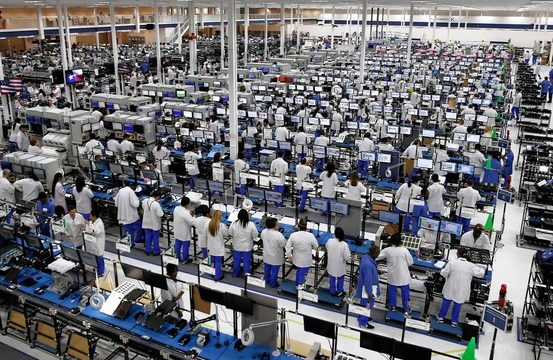Feds won’t STEM tide of foreign tech workers

WORKER BEES: A Motorola cell-phone manufacturing plant in Texas.
By Kenric Ward | Watchdog.org
WASHINGTON, D.C. — Facebook’s Mark Zuckerberg says there aren’t enough skilled U.S. workers to meet the demands of America’s high-tech sector.
Despite data showing few such labor shortages, Washington has opened the floodgates for foreign job seekers, radically expanding programs to import hundreds of thousands of science, technology, engineering and math — or STEM — workers.
TECHIE TURNED LAWYER: John Miano says he “saw the writing on the wall” and quit his programming job.
The influx of tech migrants — 690,000 by 2012 — is leaving more U.S. workers by the wayside.
“I quit my job when I saw the writing on the wall,” said John Miano, a computer programmer turned lawyer.
Since exiting the tech field, Miano said prospects for homegrown STEM workers are “getting worse because companies are finding more ways to bring people in from overseas.”
Miano is preparing a lawsuit against the federal government over non-citizen hiring. “They’re granting U.S. immigration benefits as a corporate benefit and providing the means to get cheap foreign labor,” he argues.
Blowing off the cap
Initially capped at 65,000 foreign workers per year, the quota of H-1B (skilled) worker-visas is soaring under constant prodding from such influential Facebook friends as Google, Microsoft, Apple, Intel and IBM
More than one in four U.S. STEM workers is now from overseas.
“Employers tend to give preference to foreign workers over similarly qualified Americans,” said Norm Matloff, a computer science professor at the University of California, Davis.
“Most H-1Bs are under 30, and since younger workers are cheaper than older ones — in both wages and healthcare costs — employers use the H-1B program.”
Matloff said U.S. immigration rules effectively “handcuff” the foreign STEM worker to the sponsoring employer.
“The worker dare not switch jobs, as that would entail starting the multiyear green card process all over again.”
Fewer opportunities, lower pay
A new study counters the tech industry’s claims of chronic labor shortages. Confirming earlier research, the Center for Immigration Studies found:
- Total STEM employment in 2012 was 5.3 million, but there are 12.1 million STEM degree holders.
- STEM wages (adjusted for inflation) grew a paltry 0.4 percent a year from 2000 to 2012.
- Americans with STEM degrees are either unemployed or out of the labor force.
Steve Camarota, co-author of the report, called H-1B and several similar employer-based programs “indirect subsidies for businesses.”
Matloff said the federal H-1B prevailing wage formula arbitrarily depresses pay for highly skilled tech-sector workers.
“The law is written in a way that the legal wage is substantially lower than the true market wage,” he argues.
Joe Petrides, a manager at a midsize technology firm in the D.C. area, said he sees “a lot of weird stuff going on” in the industry.
“Companies — especially the largest ones — are pushing for more H-1Bs to keep wages lower,” he said.
And some companies pay up to a 20 percent fee to “third-party bodyshops” to recruit foreign workers, often from India.
Additionally, Petrides said big corporations will steer away from full-time employees.
“Software implementation may just take five testers for eight months,” he said. “I can’t blame the companies. They have obligations to their shareholders.”
‘A narrowing of job openings’
Camarota said foreign and contract labor — here and offshore — is eroding America’s STEM workforce with government complicity.
“Middle-class natives are being crowded out,” he said.
Miano, the New Jersey lawyer who founded the Programmers Guild in 1998, confirmed Camarota’s findings.
He witnessed a wholesale transference of jobs in 1994, when his next-door neighbor and 325 other computer programmers were replaced by Filipinos at the shipping giant Sea-Land Services. Before being terminated, the Americans were ordered to train the lower-paid Filipinos, most of whom eventually returned to Manila to work even more cheaply there, the Washington Post reported.

‘THE SECRET’: Donna Conroy says “Companies can fill white-collar jobs with citizens from abroad without ever seeking local Americans first.”
Donna Conroy, a former tech employee, agreed that U.S. white-collar workers aren’t getting a fair shake.
Characterizing her departure from the tech industry after 20 years as “a combination of walking away and being pushed out,” Conroy sees “a narrowing of job openings” for domestic applicants.
She now directs Bright Future Jobs, a Chicago-based advocacy group leading a boycott against Infosys, Manpower and IBM over what Conroy calls “a pattern of excluding U.S. workers from job openings on U.S soil.”
Conroy blames corporate-engineered immigration laws for what she believes to be legal discrimination.
“The secret is that companies can fill white-collar jobs with citizens from abroad without ever seeking local Americans first. You can’t compete for a job if you can’t apply,” she said.
A pending immigration bill, S.744, would substantially increase the number of foreign workers. The measure passed the Senate but is bottled up in the House.
The U.S. Citizenship and Immigration Services, meanwhile, is sweetening the H-1B pot by:
- Allowing H-1B holders to work two jobs at a time.
- Enabling their spouses to gain employment in the U.S.
- Granting a 17-month extension for international STEM students in Optional Practical Training programs – a reservoir of even cheaper labor.
Earlier this year, Watchdog reported on widespread mismanagement and possible national-security issues at the OPT program.
Kenric Ward is a national reporter for Watchdog.org and chief of its Virginia Bureau. Contact him at kenric@watchdogvirginia.org or at (571) 319-9824. @Kenricward









